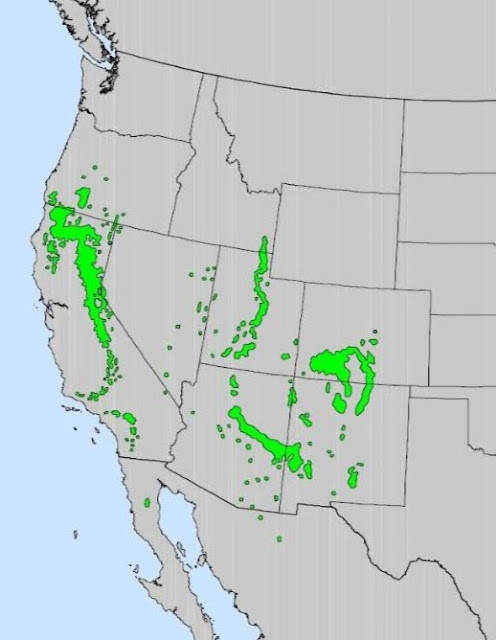(Below each description is the native range of that tree)
(Pictured above is Fraser Fir)
1. Fraser Fir (most popular Christmas tree in the U.S.)
Fraser Fir is a very popular Fir, millions are grown and millions are cut each year on tree farms across the Eastern US, it has a very small native range, and on top of that an invasive pest is killing the few trees that exist in the wild. The species is currently (as of December, 2019) set as "Endangered". There is also a national Christmas tree shortage, due to the recession that began in 2008 and lasted a few years after. Trees take 7-14 years to reach a desired size to sell as Christmas trees from the time of planting. Between 2008 and 2011 trees were planted much less than normal, and many farms simply went out of business. The effects first started to hit the consumer around 2016, it is still being felt as of the Christmas 2019 season. It will likely last a few more years into the early 2020s before many more trees will become available, and tree prices drop. Many (millions) of Fraser Firs are shipped from the same area in Western North Carolina across the country each year. It is not it's native range, but very close and the climate is virtually identical, so the trees perform at their absolute best with little problems. The problem with growing them in other really hot, or drier areas is that Fraser Firs are gentically adapted to rocky soils, and cool temps year round. Places in parts of the South and Midwest is much to hot and humid, and at times too much rain, or too much drought.
2. Canaan Fir (variety of Balsam Fir)
A variety is a tree that is gentically a certain species, but offers different gentic traits, but can reproduce in the wild unlike a cultivar which must be reproduced by means of cloning (root cuttings or graft). Canaan Fir is different from the regular Balsam Fir by exhibiting more tolerance to warmer climates (hotter summers, and slightly warmer winters) and tolerating clay soils and more rain which Fraser and regular Balsam Firs can not tolerate. Canaan Fir is still pretty rare and much unheard of, but in recent years is becoming much more popular for Christmas tree farms across the South, East, and Midwest for those specific reasons. Canaan Fir by appearance (unless by a professional botinist) can not be distinguished from regular Balsam fir. Canaan Fir looks and has the same physical attributes that everyone loves of Fraser Fir. So whether you get a Fraser, Balsam, or Canaan Fir you likely won't tell the difference, and if you can you won't care in the slightest. In the native range picture of Balsam Fir I have circled the native range of Canaan fir, which is thriving in the wild with only minimal pest issues, since it it native further south in the mountains. (native in USDA Zones 5b-6a) it is more tolerant of heat and areas not as cold as colder zones where regular Balsam Fir grows. While the regular Balsam Fir only grows in USDA Zones: 3-5, the Canaan Fir grows in USDA Zones 4-7.
3. White Fir
Concolor or White Fir has longer needles like a Pine, but are completely soft and have a blue hue to add a frosty look. When needles and branches are crushed they emit a fresh citrus smell. Native to the coastal mountains of the northwest, not too common as a Christmas tree in the East due to wet clay soils, and hot summers unlike in it's native range. Surprisingly though it does fine with clay soils (with aduquete drainage) and hot humid summers unlike other conifers from the same region grown East. So it is unfortunately greatly underused as a Christmas tree. Hardy in USDA Zones: 3-7.
4. Noble Fir
Also a native of the coastal mountains of the Northwestern US this tree looks very similar to Balsam, Fraser, and Canaan, but it's needle grow straight up to add a more compact look. Not tolerant to clay soils, high heat and humidity. So not too common as Christmas trees in the East, very commonly grown out west though. Hardy in USDA Zones: 5-6.
5. Nordmann fir
Nordmann Fir is native to a large part of Europe and is the number 1 Christmas tree for much of Europe. It is the Fraser Fir of Europe. Looks very similar to Balsam, Fraser, and Canaan Fir, and has all the same qualites of those that people want as a Christmas tree. Nordmann Fir likely has the best needle retention of any conifer, with Fraser Fir being a close second. This tree is known to hold needles for close to two months before dropping needles. While the most popular European Christmas tree in the US is Scotch Pine, it is Nordmann Fir in Europe, while Scotch Pine remains a good option if all else fails in Europe. Usually not grown in North America, and may be difficult to find this tree. You may have to have seeds shipped from overseas to grow some. They are hardy in USDA Zones: 4-7. Nordmann Firs are virtually pest and disease free, and perform well in clay soils, with hot/humid summers. They may be another good alternative to Fraser Fir, although not too much testing for growing these trees have been done in North America.








Outstanding Andrew! Great information.
ReplyDeleteThanks!
Delete